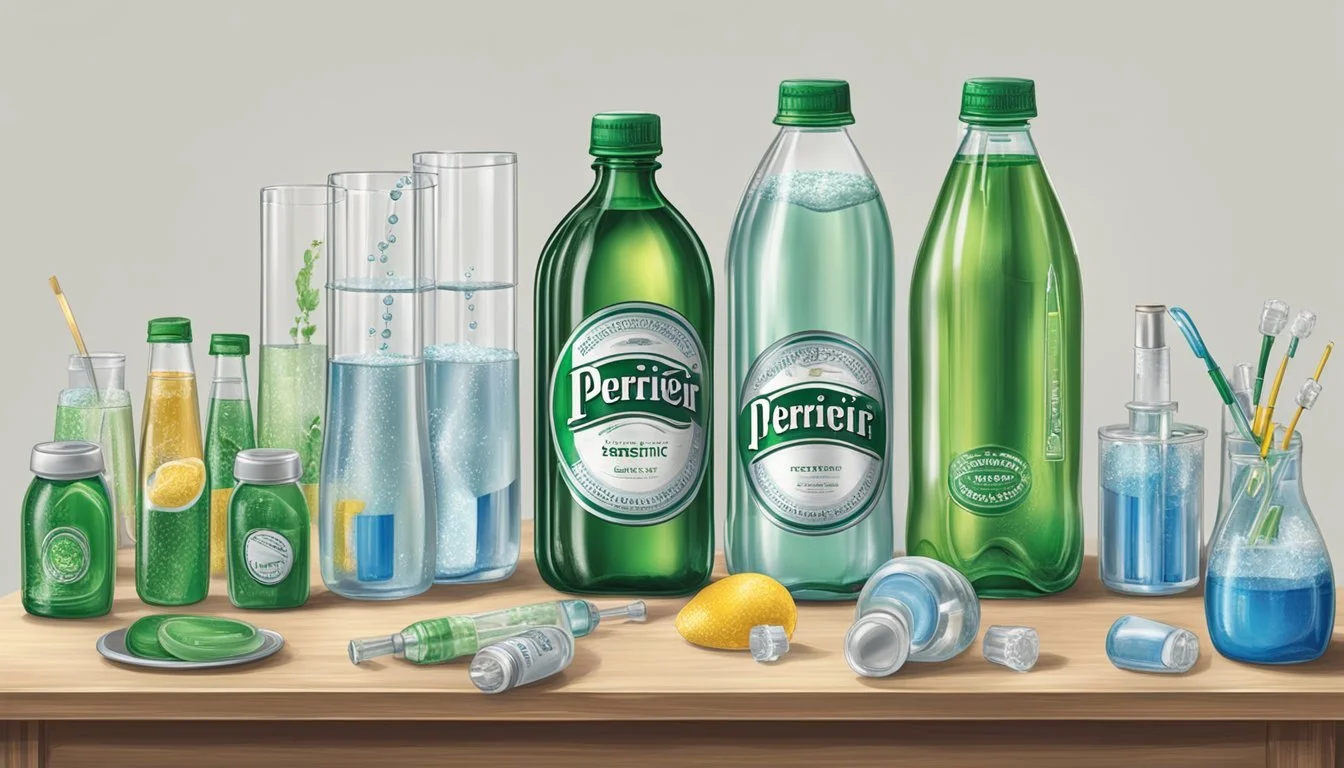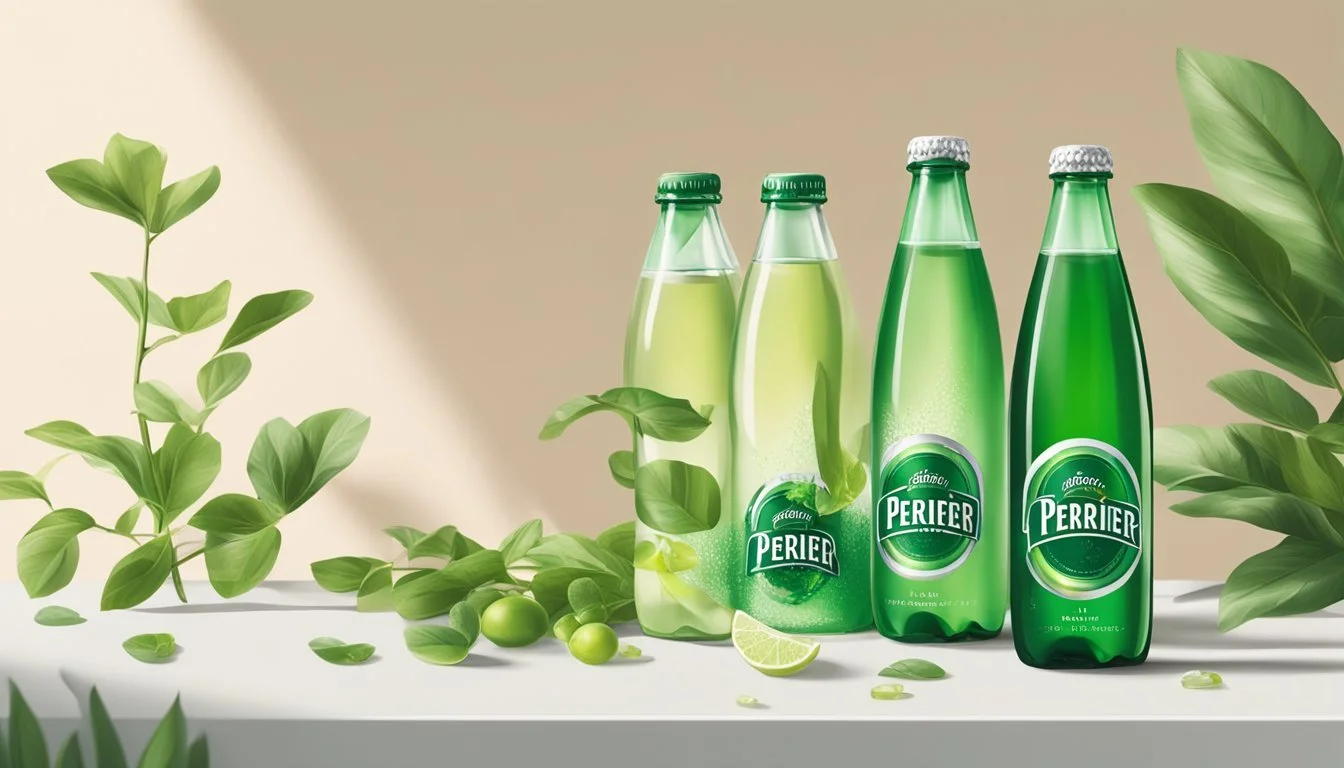Essentia vs. Perrier
Comparing Quality and Taste for the Best Hydration Choice
When choosing bottled water, many factors come into play: taste, purity, mineral content, and pH levels all play a part in consumer preferences. Two brands that stand out on the global stage are Essentia and Perrier. Essentia is known for its high pH level, which at 9.5 is intended to complement a more alkaline diet, claiming to offer hydration with a clean and smooth taste. These attributes are often contrasted with sparkling contenders like Perrier, which is a naturally carbonated mineral water with a distinct taste that comes from the unique spring source located in Vergèze, France.
While Essentia purports to deliver health benefits through its ionization process that removes bitter-tasting acidic ions to achieve a higher pH, Perrier markets itself with a focus on its rich mineral content and its signature fizz, presenting more than just hydration but a unique sensory experience. Their approaches to branding and product benefits reflect differing consumer appeals; Essentia emphasizes its process and purported health benefits, whereas Perrier emphasizes natural origin and a touch of luxury.
Selecting between these two brands isn't just about quenching thirst—it's about personal preferences and the experience one seeks from a bottle of water. Consumers decide based not only on what's in the water itself but on how it fits into their lifestyle and aligns with their health beliefs. As such, a comparison of Essentia and Perrier isn't merely water against water, it's a discussion on the contrasting philosophies of hydration.
Overview of Bottled Water
Bottled water, an industry driven by consumers' need for convenience and quality, varies widely in source and treatment methods. This section provides a concise overview of its origins, the different types available, and the notable brands in the market.
History of Bottled Water
The commodification of water in portable containers dates back centuries. Originally, bottled water was often sourced from mineral springs and consumed for its purported health benefits. As the understanding of waterborne diseases improved, the demand for bottled water increased, particularly in urban areas lacking safe drinking water. Today, it represents a daily necessity for many and a luxury for others, signifying a shift from luxury to an essential good.
Types of Bottled Water
Bottled water can be broadly categorized into several types based on its origin and treatment:
Mineral Water: Originates from a mineral spring, contains various minerals like salts and sulfur compounds.
Spring Water: Derived directly from a spring where water naturally rises to the surface.
Purified Water: Water that has been processed to remove chlorine and other contaminants; not necessarily sourced from a spring.
Sparkling Water: Water that contains carbon dioxide gas, either naturally occurring or added, resulting in effervescence.
Bottled Water Brands
The bottled water market is populated with numerous brands, each offering a unique selling proposition based on source, taste, and mineral content. A few brands include:
Perrier: Known for its naturally occurring carbonation and unique green bottle.
Essentia: Offers ionized alkaline water that it claims is better for hydration.
Fiji: Sources its water from an artesian aquifer in Viti Levu, known for its soft mouthfeel and presence of minerals.
As the industry continues to grow, consumers are faced with a plethora of choices, ranging from inexpensive, purified water to premium brands touting unique mineral profiles and health benefits.
Essentia Water Analysis
In assessing Essentia Water, it is vital to consider the brand's origins, its unique production process, and the health-related benefits it promotes due to its high pH and added electrolytes.
Product Origin and Company Background
Essentia began with the goal to create a bottled water that not only offered hydration but also boasted additional health benefits. They targeted consumers looking for products contributing to a more balanced lifestyle. Its headquarters are located in Bothell, Washington, and it positions itself in the market as a premium bottled water brand.
Production Process
Essentia Water undergoes a proprietary process that includes microfiltration, reverse osmosis, and an ionization process to remove impurities and produce alkaline water. After the filtration stages, Essentia adds a blend of electrolytes for taste, which complements the 9.5 pH level of the water. This rigorous purification process ensures the water is free from contaminants while maintaining the hydration benefits of alkaline water.
Microfiltration: Removes small particles and contaminants
Reverse Osmosis: Further purifies by filtering out smaller impurities
Ionization: Raises the pH to create alkaline water
Health Benefits and Claims
Essentia Water asserts that its alkaline water with a pH of 9.5 can help maintain the acid-base balance in the body, which is believed to offer various health benefits. Additionally, the presence of electrolytes for taste is intended to enhance hydration. While these claims resonate with consumers seeking wellness through their diet, it is essential to note that conclusive scientific support for the long-term benefits of alkaline water consumption is limited.
Hydration: Aimed to improve hydration beyond regular water due to added electrolytes
Alkaline properties: Suggested to help with the body's acid-base balance
Antioxidants: Claims of antioxidant effects due to ionization and alkalinity
The company's claims that ionized, high-pH water can offer improved hydration and health benefits align with some consumer testimonies, but individual experiences can vary. Essentia focuses on a process that asserts a superior product in the competitive bottled water market.
Perrier Water Analysis
In examining Perrier water, one considers its history, unique qualities, and the range of flavors offered. Perrier is a brand that has built a reputation for its mineral water, which is well-known for being carbonated and sourced from a unique aquifer in the south of France.
Product Origin and Company Background
Perrier water originates from the Vergèze spring located in the Gard département of France. The brand dates back to 1863 when the local doctor Louis Perrier first bought the spring, which later took his name. The water is naturally carbonated by the volcanic gas in the ground, but additional CO2 is added by the company to match the levels in the original spring water.
Distinctive Features
The mineral content of Perrier water, combined with the carbonation that includes added CO2, makes this drink distinct. The water is characterized by its fine bubbles and the balance of minerals, coming from the deep limestone layers it filters through. The addition of extra carbonation enhances Perrier's refreshing crispness – a signature trait that sets it apart from still mineral waters.
Flavor Varieties
Perrier offers a variety of flavors in addition to its classic natural mineral water. These flavors are designed to cater to diverse palates and include options such as lime, lemon, and pink grapefruit. Each flavor infuses a subtle taste that complements Perrier's effervescence, offering a light alternative to sugary soft drinks while maintaining the mineral content that consumers expect from the brand.
Comparative Analysis
This analysis provides a detailed overview of the differences between Essentia and Perrier bottled waters, looking at taste, mineral content, pH level, packaging, and price.
Taste Test
Essentia Water is often described as smooth and clean-tasting, with a high pH that could contribute to its taste profile. Perrier, on the other hand, is carbonated mineral water that gives it a distinctly bubbly and acidic taste. The preference for flat versus sparkling water plays a significant role in an individual's taste assessment of these two brands.
Mineral Content Comparison
The mineral content of bottled waters can significantly affect their flavor and nutritional value. Perrier is known for its rich mineral content, including minerals such as calcium and magnesium, which are naturally occurring in its water source. Essentia, however, has minerals added for taste and electrolytes. It's relevant to note that mineral needs can vary by individual, and thus preference for more or less mineral content is subjective.
pH Level Assessment
The pH level of water can influence its taste and potential health benefits. Essentia Water boasts a pH level of 9.5, which is substantially higher than that of most bottled waters, including Perrier, which has a slightly acidic pH of around 5.46. Higher pH levels can help to balance acidic diets, while lower levels may be preferred by those who enjoy the sharpness of carbonated waters.
Packaging Considerations
Packaging may affect water quality and environmental impact. Both Essentia and Perrier use plastic bottles, but Perrier also offers glass bottles, which can preserve carbonation better and reduce plastic use. Eco-conscious consumers often prefer packaging that minimizes environmental impact.
Price Comparison
When comparing prices, Perrier is typically positioned as a premium carbonated water brand, which might reflect in its price point. Essentia, being marketed mainly for its high pH levels, is also priced higher than standard bottled waters like Aquafina or Pure Life but may vary based on the retailer. Consumers often weigh the price against perceived benefits and personal preference for water type.
Health and Safety Standards
When evaluating bottled water brands like Essentia and Perrier, it's critical to consider the health and safety standards they adhere to, including regulatory compliance and stringent testing protocols that ensure the quality of the water.
Regulatory Bodies and Guidelines
Essentia and Perrier are subject to regulations by the Environmental Protection Agency (EPA) for tap water and the Food and Drug Administration (FDA) for bottled water standards, which are similar though not identical. The FDA enforces standards for bottled water that include limits on contaminants such as heavy metals, ensuring the safety of the product.
EPA regulations: Monitor tap water for pollutants.
FDA regulations: Oversee bottled water, insisting on standards for:
Microbial purity
Contaminant levels: Including heavy metals, like lead or mercury.
Sanitation: Of bottling facilities.
Brands often surpass these basic requirements to establish trust with consumers. For instance, Perrier, sourced from a well in France, is known for its natural carbonation and mineral content, and must align with both European and U.S. standards. Essentia claims its water is ionized to remove bitter-tasting ions and enhance taste.
Testing Protocols and Quality Control
Both Essentia and Perrier utilize strict testing protocols to maintain water quality and safety, consistently checking for contaminants and ensuring a clean product.
Essentia utilizes a proprietary process that includes:
Purification: Water is purified through microfiltration and reverse osmosis.
Electrolytes: Adding a blend of electrolytes for taste without compromising purity.
Perrier focuses on maintaining the natural purity of their water and regular testing confirms:
Mineral content: Naturally occurring minerals are kept at consistent levels.
Carbonation: Its iconic effervescence is the result of natural geological processes.
Both brands are subject to internal quality control and periodic checks. For example, Nestlé, which owns Perrier, has faced scrutiny over its bottled water products like Nestlé Pure Life and San Pellegrino but maintains that it adheres to stringent quality standards. Similarly, Essentia, although not implicated by association with a major conglomerate like Nestlé (owner of brands like Nestlé Pure Life and San Pellegrino), independently asserts that its water surpasses typical purification standards.
Environmental Impact
The environmental impact of bottled water is significant, particularly in terms of water source sustainability and the consequences of packaging and recycling practices. The following subsections explore these aspects for Essentia and Perrier.
Water Source Sustainability
Essentia sources its water from various municipalities, then purifies it through a process involving microfiltration, reverse osmosis, and ultraviolet exposure. This brand's process does not rely directly on natural spring or aquifer sources, which can mitigate the risk of over-extraction of natural groundwater reserves.
Perrier, on the other hand, is sourced from a spring in Vergèze, located in the Gard département of France. The brand's extraction from this source is subject to environmental regulations aimed at preserving the natural state of the aquifer. It is crucial that they manage their water sourcing sustainably to avoid depleting the aquifer or causing inadvertent contamination of surrounding groundwater.
Essentia: Municipal, Purified Water
Perrier: Spring, Aquifer
Packaging and Recycling
The packaging choices of both Essentia and Perrier contribute to their environmental footprints. Essentia uses plastic bottles, which are BPA-free and recyclable. They emphasize the importance of recycling to reduce the impact of their packaging on the environment.
Perrier offers their water in glass and plastic bottles, with the glass options presenting a more environmentally friendly alternative due to the higher recyclability and lower contamination risk of glass compared to plastic. However, the heavier weight of glass increases transportation fuel consumption and associated emissions.
Both companies face challenges in ensuring their packaging is actually recycled, as global recycling rates vary and not all products enter the recycling stream.
Essentia: BPA-free Plastic, Recyclable
Perrier: Glass and Plastic, Recyclability varies by material
Consumer Preferences
When it comes to bottled water, consumer preferences often hinge on personal taste and perceived health benefits. Factors such as brand reputation, mineral content, and pH level play significant roles in influencing purchasing decisions.
Trends in Consumption
Consumers are increasingly leaning towards brands that offer added health benefits, such as high pH levels and natural electrolytes. Brands like Essentia, touting alkaline water with a pH of 9.5, are gaining popularity for their claims of better hydration and acid-base balance. On the other hand, naturally carbonated options like Perrier, derived from a specific spring in France, appeal to those preferring a hint of fizz with mineral enrichment.
Notable brands that have captured consumer interest due to their unique selling propositions include:
Eternal Water: Known for its naturally occurring electrolytes
Mountain Valley Spring Water: Sourced from a single spring in the Ouachita Mountains
Evamor: Recognized for its naturally high pH
In contrast, traditional springs such as Zephyrhills and Ice Mountain Natural Spring Water remain in steady demand, showing a continued preference for natural spring waters.
Convenience and Accessibility
In a fast-paced world, consumers often prioritize convenience. Major players like Nestlé Pure Life and PepsiCo’s Life WTR have established extensive distribution networks, making their products easily accessible across various outlets.
Convenience factors include:
Portability: Individual and multi-pack options that cater to on-the-go consumption.
Availability: Wide availability in supermarkets, vending machines, and online stores.
Brands like Core Hydration and LaCroix leverage their omnipresence and easy-to-recognize packaging to capture the attention of hydration-conscious consumers. In addition, brands such as Crystal Geyser Natural Alpine Spring Water and Ozarka Natural Spring Water have found their way into many homes due to their widespread availability.
Conversely, brands like Arrowhead Mountain Spring Water and Deer Park Natural Spring Water must compete with these giants by emphasizing the origin and purity of their mountain springs, despite the widespread distribution of larger conglomerates such as Nestlé.
Conclusion
In considering the benefits of Essentia versus Perrier bottled water, consumers should weigh factors such as pH levels, mineral content, and the presence of additives.
Summary of Findings
Perrier, a carbonated mineral water, has a slightly acidic pH typically ranging from 5.5 to 5.46. This carbonation can deliver a refreshing taste but may not be the optimal choice for those with specific kidney health concerns that require monitoring of acid intake. In contrast, Essentia promotes an alkaline water with a pH of 9.5, achieved through a proprietary ionization process. This high pH suggests it might help with maintaining an acid-base balance, although consumers should be aware that Essentia contains added electrolytes.
Brand pH Level Carbonation Additives Perrier 5.5 - 5.46 (acidic) Carbonated Naturally occurring minerals Essentia 9.5 (alkaline) Non-carbonated Electrolytes
While not specifically mentioned in the available data, smart water is another brand that is often compared to these two. It is vapor-distilled with added electrolytes for taste.
Best Practices for Consumers
Consumers should select bottled water based on their individual health needs, taste preference, and consideration for the environment. They may choose non-carbonated alkaline waters like Essentia if the goal is to maintain a balance in their body's pH level, especially during physical exertion where electrolyte balance becomes essential. On the other hand, for those who prefer a crisp taste with the benefits of natural minerals, a sparkling water like Perrier may be more appropriate. Those looking for a middle ground might consider smart water for its added electrolytes and purification process without carbonation.
For kidney health: Select bottled water with a balanced pH and low in additives.
Taste preference: Choose carbonated waters like Perrier for a crisp taste, or non-carbonated like Essentia for a smooth feel.
Physical activity: Consider a water like Essentia with added electrolytes for replenishment.
Each brand has distinct characteristics that serve different preferences and needs. It is crucial for consumers to make well-informed choices based on reputable information and their personal health profiles.
References
Essentia Water
pH Level: Essentia water is known for its high pH of 9.5, indicating it is an alkaline water.
Purification Process: The brand uses a combination of microfiltration and reverse osmosis in its purification process.
Price and Market Positioning: Often marketed through endorsements from social media personalities, Essentia water typically carries a higher price point.
Perrier
Composition: Perrier is a carbonated mineral water, with a distinct composition that includes various minerals.
Comparative Nutrition: Perrier is contrasted with non-carbonated bottled waters through its mineral content and carbonation, and is often compared in terms of diet suitability, such as low-fat or low-carb diets.
Brand Pedigree: Perrier is recognized for its long-standing reputation as a premium sparkling mineral water.
Sources
Comparative snippets from search results regarding Essentia's purification process and its pH level.
Information on Perrier's nutritional comparison with bottled water and its brand reputation in the marketplace.
No specified references for nutritional values and comparisons; information extracted from search results and general knowledge.
Table 1: Water Properties
Property Essentia Perrier Type Alkaline Water Carbonated Mineral Water pH Level 9.5 Not Specified Purification Microfiltration, Reverse Osmosis Natural Sources Notable Aspects High pH, rigorous filtration process Carbonation, mineral content
Considering the factors above helps in comprehending the unique selling points and characteristics of each brand, allowing consumers to make informed decisions based on their own preferences and the benefits each product offers.








